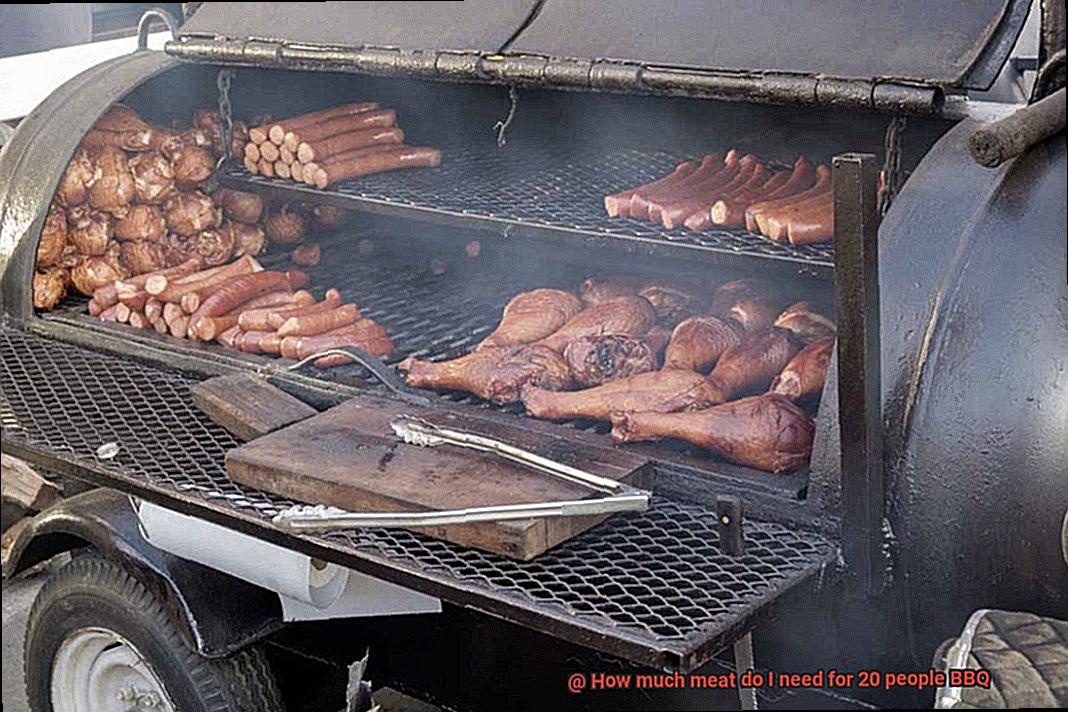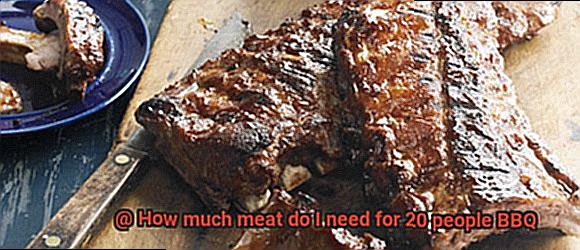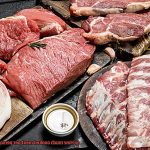Summer may be winding down, but that doesn’t mean the BBQs have to stop. Whether you’re throwing a birthday bash, hosting a family reunion, or just having a casual get-together with friends, one of the biggest questions on your mind is likely “How much meat do I need for 20 people BBQ?” Because let’s face it – no one wants to run out of food or be left with a mountain of leftovers.
But don’t fret. As someone who loves to fire up the grill and cook up some delicious meaty goodness, I’m here to help. In this blog post, we’ll explore the factors you need to consider when determining how much meat to buy for your 20-person BBQ. We’ll look at everything from the type of meat you want to serve (brisket? ribs? chicken?) to how hungry your guests are likely to be and whether you plan on serving sides.
So buckle up and get ready for some mouth-watering tips and tricks. By the end of this post, you’ll have all the information you need to make sure your next BBQ is a hit. Your guests will leave feeling full, happy, and already planning their next visit.
Contents
The Type of Meat and Serving Size
One key aspect is selecting the appropriate type of meat and serving size to satisfy all your guests’ appetites.
When it comes to meat options, you have a wide range of choices, including beef, pork, chicken, and fish. It’s essential to consider your guests’ dietary preferences when making your selection.
Beef is a popular choice for BBQs, and you should plan on serving a minimum of 1/3 to 1/2 pound per person. For a group of 20 people, you’ll need approximately 7-10 pounds of beef. Some crowd-pleasing cuts include brisket, ribs, and burgers.
Pork is another fan-favorite option for BBQs, and you should aim for the same serving size as beef – around 1/3 to 1/2 pound per person. With 20 guests, plan on purchasing roughly 7-10 pounds of pork. Popular cuts include pulled pork and ribs.
If you’re looking for a leaner protein option, chicken is an excellent choice. Plan on having around 1/4 to 1/3 pound per person. For a group of 20 people, you’ll need approximately 5-7 pounds of chicken. Some popular cuts include wings and drumsticks.
For seafood lovers, fish is a healthy option that’s sure to please. Aim for approximately 6-8 ounces per person. For a group of 20 people, you’ll need approximately 7-10 pounds of fish. Some popular choices include salmon and shrimp skewers.
Remember that these serving sizes are estimates only and may need adjusting based on your guests’ appetites. If you plan on serving multiple types of meat, adjust the serving sizes accordingly.
In addition to selecting the right type of meat and serving size, don’t forget to consider any dietary restrictions and side dishes. If you plan on serving sides, you may be able to reduce the amount of meat you need to purchase. And if any of your guests have dietary restrictions, be sure to provide alternative options.
Sides and Dietary Restrictions
A BBQ is a great way to bring people together, but it’s important to keep in mind that not all guests will be able to eat the same dishes due to dietary restrictions. So, let’s dive into some tips and tricks on how to plan a successful and inclusive BBQ.
Accommodating Different Dietary Needs
The first step in planning your BBQ sides is to consider the dietary needs of your guests. Not everyone will be able to eat meat, so it’s important to provide vegetarian or vegan options. Grilled vegetables, veggie burgers, and tofu skewers are great options for non-meat eaters.
It’s also important to consider other dietary restrictions, such as gluten-free or dairy-free diets. By providing a variety of side dishes that cater to different dietary needs, you can ensure that all guests can enjoy the meal.

Sides That Everyone Will Love
Now that we have addressed accommodating dietary restrictions, let’s talk about some delicious side dish options that will satisfy all taste buds. Some popular BBQ side dishes include corn on the cob, baked beans, coleslaw, potato salad, and macaroni and cheese.
When deciding how much of each side dish to make, a good rule of thumb is to plan for about 1/2 cup per person. However, this may vary depending on how many sides you are serving and your guests’ appetites.
Labeling and Customizing Sides
It’s important to consider the seasonings and sauces you use on your sides. Make sure to label any dishes that contain allergens such as nuts or dairy. Providing a variety of sauces and condiments will allow guests to customize their meals to their liking.
Also, consider offering additional toppings for guests with specific dietary needs. For example, if you’re serving a salad as a side, consider offering gluten-free croutons or dairy-free dressing options.
Calculating the Amount of Meat Needed for 20 People
With a few simple calculations, you can ensure that everyone leaves happy and satisfied.
First, decide on the type of meat you’ll be serving. Will it be succulent beef, mouth-watering chicken, juicy pork, or a combination of all three? Once you’ve made your decision, it’s time to start calculating.
A good rule of thumb is to plan for approximately 8 ounces of meat per person. This means that for 20 people, you’ll need around 10 pounds of meat. However, keep in mind that this is just an estimate and several factors can affect the amount of meat you’ll need.
One key factor to consider is whether you’ll be serving bone-in or boneless meat. Bone-in meats tend to weigh more than boneless meats, so if you’re planning on serving ribs or chicken wings with bones, you may need to adjust your calculations accordingly. Additionally, cooking methods such as grilling or smoking can cause meats to shrink, so it’s best to factor in some extra meat to account for this shrinkage.
Another important consideration is any dietary restrictions or preferences your guests may have. If you have vegetarian or vegan guests attending, make sure to provide alternative options such as veggie burgers or grilled vegetables.
Buying in Bulk vs. Individual Packaging
Buying in bulk can be a cost-effective option, allowing you to save money in the long run. However, it requires sufficient storage space and proper preparation. You’ll need to invest in a large freezer or cooler to keep the meat fresh until the day of your BBQ. Also, thawing and preparing large amounts of meat can take more planning and time.
In contrast, individual packaging can be a convenient option for those with limited storage space or who prefer not to deal with thawing out large amounts of meat. But it might be more expensive than buying in bulk and can leave you with excess packaging waste.
When considering which option is right for you, think about your budget, storage space, and level of preparation required. To help you decide, let’s explore the pros and cons of each option further.
Buying in Bulk
Pros
- Saves money in the long run
- You’ll have enough meat for everyone without worrying about running out
- Can be purchased from a local butcher or farmer’s market
Cons
- Requires adequate storage space
- Proper preparation is necessary
- More planning and time needed
Individual Packaging
Pros
- Convenient for those with limited storage space
- Less preparation required
- Easy to portion control

Cons
- More expensive than buying in bulk
- Excess packaging waste
It’s evident that each option has its advantages and disadvantages. Therefore, it’s up to you to decide which option works best for your specific needs and preferences. By weighing the pros and cons of each option, you can ensure that you have enough meat for your BBQ without breaking the bank.
Storing the Meat Before the BBQ
Barbeques are the perfect way to enjoy the warm weather and bond with friends and family. However, before you can get your grill on, it’s essential to consider how you’ll store your meat beforehand. Here are some expert tips on how to ensure your meat stays fresh and safe to eat before your 20 people BBQ.
Purchase Meat From a Reputable Source
The first step in proper meat storage is purchasing it from a trustworthy source. Look for signs of discoloration or bad odor, and check the expiration date. This will guarantee that the meat is fresh and safe to eat.
Keep Meat Refrigerated
To prevent bacterial growth and keep your meat fresh, refrigerate it at a temperature below 40°F (4°C). If you’re not going to use the meat within two days, freeze it.
Freeze Meat Properly
When freezing meat, wrap it tightly in plastic wrap or aluminum foil to prevent freezer burn. This will ensure that the meat retains its texture and flavor. Additionally, label the package with the type of meat and the date it was frozen to help you keep track of how long it’s been in the freezer.
Thaw Meat Safely
Never leave meat out at room temperature to thaw, as this can encourage bacterial growth and make the meat unsafe to eat. Instead, thaw your meat in the refrigerator or in a bowl of cold water. This will ensure that the meat stays at a safe temperature while it thaws.
Don’t Cross-Contaminate
When storing raw meat, make sure it’s separate from ready-to-eat foods like fruits and vegetables. This will prevent cross-contamination and reduce the risk of foodborne illness.
Different Types of BBQs and Their Meat Requirements
Planning a BBQ party for 20 people requires careful consideration of the different types of BBQs and their meat requirements. The type of BBQ you choose can significantly affect how much meat you need to serve your guests. Here are five sub-sections that will help you plan the perfect BBQ.
Classic American BBQ
The classic American BBQ is a popular choice for many people. It typically includes smoked meats such as brisket, ribs, and pulled pork. For a party of 20 people, plan for around 5 pounds of meat per person, which means you’ll need around 100 pounds of meat in total. Keep in mind that these meats take hours to cook properly, so plan accordingly.
Backyard Cookout
If you’re having a casual backyard cookout, burgers and hot dogs are always crowd-pleasers. For this type of BBQ, plan for around 2-3 burgers or hot dogs per person. So for 20 people, you’ll need approximately 40-60 burgers or hot dogs. Don’t forget to have vegetarian options available, such as veggie burgers or grilled vegetables.
Steakhouse-style BBQ
If you’re planning an upscale BBQ, such as a steakhouse-style BBQ, you’ll need to adjust your meat requirements accordingly. For 20 people, plan for approximately 10-15 pounds of steak, depending on how many sides and appetizers you plan to serve. Remember that steaks come in different sizes and cuts, so make sure to choose the right ones that will satisfy your guests.
Southern-style BBQ
Another popular type of BBQ is the Southern-style BBQ, which includes slow-cooked meats like pulled pork and brisket. For 20 people, plan for approximately 10-12 pounds of pork shoulder or brisket. It’s also important to have plenty of sides and sauces available to complement the meat. Consider serving coleslaw, mac and cheese, and baked beans.
Seafood BBQ
For those who are feeling adventurous, a seafood BBQ is a great option. Grilled shrimp, salmon, and lobster tails are all delicious choices. For 20 people, plan for around 1 pound of seafood per person. This means you’ll need approximately 20 pounds of seafood in total. Make sure to have some vegetarian options available as well, such as grilled vegetables or tofu skewers.
Tips for Preparing the Perfect BBQ
Preparing the perfect BBQ requires some careful planning and consideration of several factors. Here are some tips to help you get started:
Determine how much meat you need
The first step in preparing the perfect BBQ is figuring out how much meat you need. A good rule of thumb is to plan for about 1/2 pound of meat per person. For a group of 20 people, you will need approximately 10 pounds of meat. However, this can vary based on the types of meat you choose to serve and the appetite of your guests. Make sure to account for any big eaters in your party and consider offering a variety of meats.
Offer a variety of meats
Nothing makes a BBQ more enjoyable than having a variety of meats to choose from. Consider offering beef, chicken, pork, and even vegetarian options like grilled vegetables or tofu. This will cater to different tastes and preferences and ensure everybody has something they love.
Don’t forget the sides
While meat is the star of the show at any BBQ, it’s equally important to have delicious sides and accompaniments. Popular options include baked beans, potato salad, coleslaw, corn on the cob, and fresh fruit. Make sure to have a variety of options available that complement your meats.
Make sure you have the right equipment
To grill your meats to perfection, it’s important to have the right equipment on hand. This includes a quality grill, tongs and spatulas, meat thermometers, and plenty of charcoal or propane. Don’t forget to check that everything is in good working order before your party.
Consider any dietary restrictions
It’s important to take into account any dietary restrictions your guests may have. Make sure you provide alternative options such as vegetarian or gluten-free dishes to accommodate everyone’s needs.
XgBWgf-VpGk” >
Conclusion
In conclusion, hosting a BBQ party for 20 people is no small feat. To ensure that everyone leaves with a full belly and a smile on their face, there are several factors to consider. The type of meat you choose to serve is crucial, as well as the serving size, dietary restrictions, sides, and equipment.
When it comes to selecting the perfect meat and serving size, keep your guests’ dietary preferences and appetite in mind. Beef, pork, chicken, and fish are all popular options for BBQs. And don’t forget about those pesky dietary restrictions – make sure you have options for vegetarians or those with food allergies.
Proper storage is also essential in ensuring that your meat stays fresh before your BBQ. Whether you opt for bulk or individual packaging depends on your budget and storage space.
But the perfect BBQ isn’t just about the meat – it’s about the sides too. Offering a variety of sides will cater to different tastes and preferences while ensuring that everyone has something they love. And don’t forget about having the right equipment on hand – nothing ruins a good BBQ like realizing you forgot tongs or charcoal.
By following these tips and tricks, you can guarantee that your next BBQ will be one for the books.






